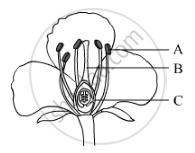Advertisements
Advertisements
प्रश्न
Find the odd one out:
पर्याय
Stigma
Anther
Style
Ovary
उत्तर
Anther
APPEARS IN
संबंधित प्रश्न
Name the parts labelled as A, B, C and D in the diagram given below:-

Name the parts A, B and C shown in the following diagram and state one function of each.

Answer the following question.
State significance of pollination.
Name and differentiate between the two modes of pollination in flowering plants.
Give one example of a unisexual flower.
You are asked by your teacher to study the different parts of an embryo of a gram seed. Given below are the steps to be followed for the experiment:
I. Soak the gram seeds in plain water and keep them overnight.
II. Cut open a soaked seed and observe its different parts.
III. Take some dry gram seeds in a petri dish.
IV. Drain the excess water.
V. Cover the soaked seeds with a wet cotton cloth and leave them for a day.
The correct sequence of these steps is :
(A) III, I, V, IV, II
(B) III, I, II, IV, V
(C) III, IV, V, I, II
(D) III, I, IV, V, II
Explain what you understand by sexual reproduction.
Sketch the reproductive parts of a flower.
Name the part made up of the stigma, style and ovary.
Name the swollen lower part of the carpel.
What is the name of female part of a flower?
Fill in the following blank with suitable word :
Pollen grains contain ............ gametes of a plant.
Fill in the following blank with suitable word :
Ovules contain ......... gametes of a plant.
Fill in the following blank with suitable word :
The.......... at the base of the carpel contains egg cells.
What is made in anther of a flower?
What is made in ovary of a flower?
What is seed? What are the parts of a seed? Explain with the help of a labelled diagram.
In the figure given alongside, the parts marked A, B and C are sequentially :
(a) cotyledon, plumule and radicle
(b) plumule, radicle and cotyledon
(c) plumule, cotyledon and radicle
(d) radicle, cotyledon and plumule
The part of a seed which grows and develops into root on germination is :
(a) cotyledon
(b) plumule
(c) follicle
(d) radicle
Fill in the blanks:
A carpel consists of ________ , ________ and ________.
What part is played by stamens and carpels in reproduction?
The students of a class were asked by the teacher to study the different parts of an embryo of an angiosperm. Given below are the essential steps for the experiment :
A. Soak the seeds in plain water and keep them overnight.
B. Cut open the soaked seed and observe its different parts.
C. Take some healthy seeds in a petri-dish.
D. Drain the excess water, cover the seeds with a wet cotton cloth and leave them as it is for a day.
The correct sequence of these steps is
(a) C, A, D, B
(b) C, D, A, B
(c) A, C, D, B
(d) A, C, B, D
Distinguish between unisexual and bisexual flowers giving one example of each. Draw a diagram showing process of germination of pollen grains on stigma and label the following parts:
(a) Female germ cell
(b) Male germ cell
(c) Ovary
Describe an activity to demonstrate phototropism.
List any two differences between pollination and fertilisation.
Which of the following is not an unisexual flower?
a) Coconut
b) Papaya
c) Gulmohor
d) Maize
Fill in the blanks and rewrite the completed statements:
Lymph flows in _______________ direction.
A student is observing the temporary mount of a leaf peel under a microscope. Draw a labelled diagram of the structure of stomata as seen under the microscope
What does germination mean?
Match the following
| 1. | Petal | Opuntia |
| 2. | Fern | Chrysanthemum |
| 3. | Phylloclade | Attracts insect |
| 4. | Hooks | Spore |
| 5. | Sucker | Bignonia |
The essential parts of a flower are ______.
Which of the following are the chemical components of the wall of pollen tube?
Pineapple fruit develops from ______.
Complete the table
| Carly x | ______ | ______ |
| ______ | petal | attract insects |
| Androecium | ______ | Male reproductive part |
| ______ | ______ | Female reproductive part. |
State the number of sets of chromosomes present in a zygote.
Give any two examples of agents of pollination.
- Assertion: Primary endosperm nucleus is diploid.
- Reason: It is the product of double fertilisation.
